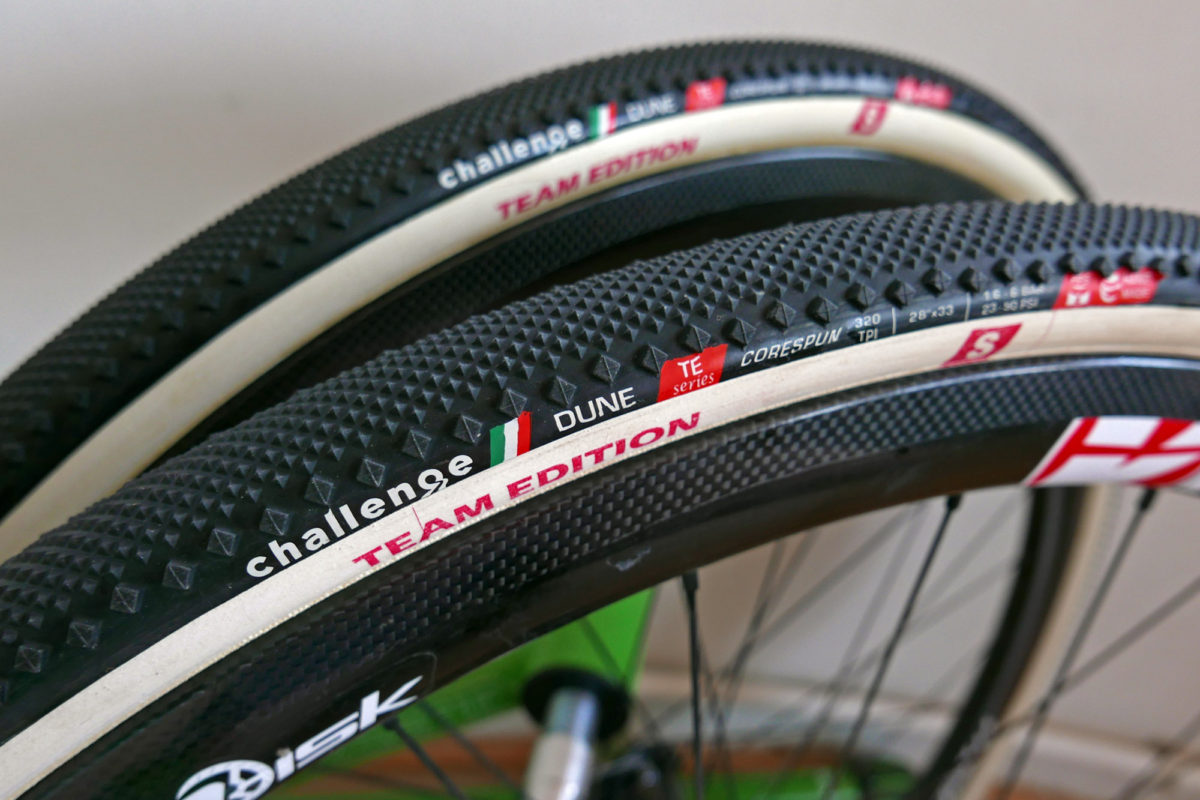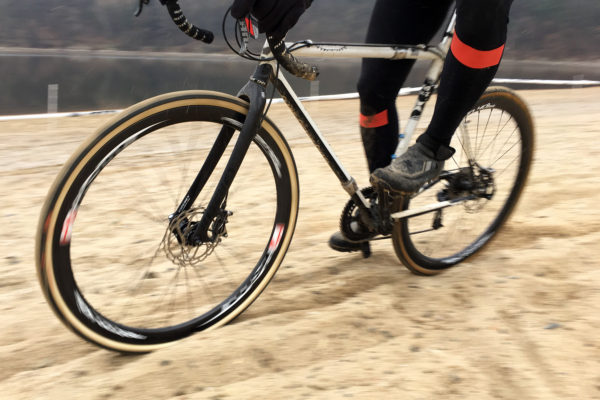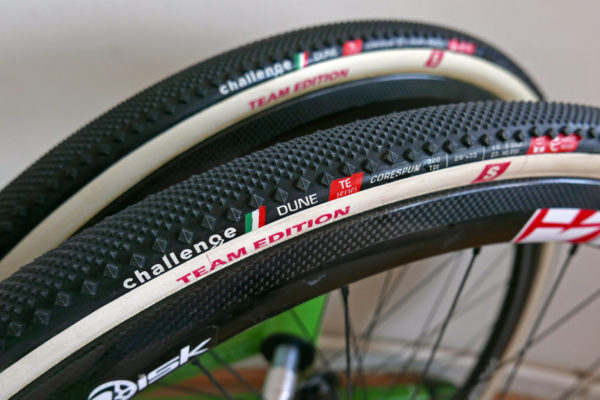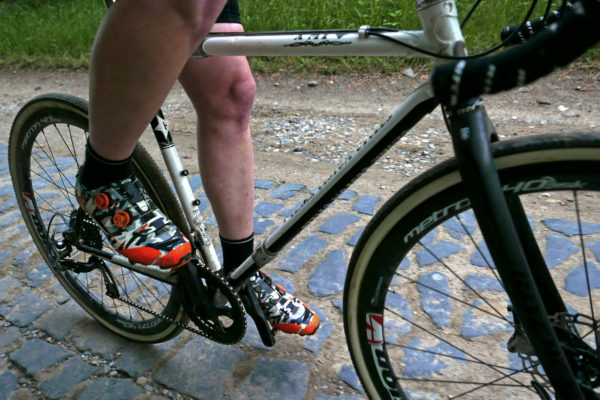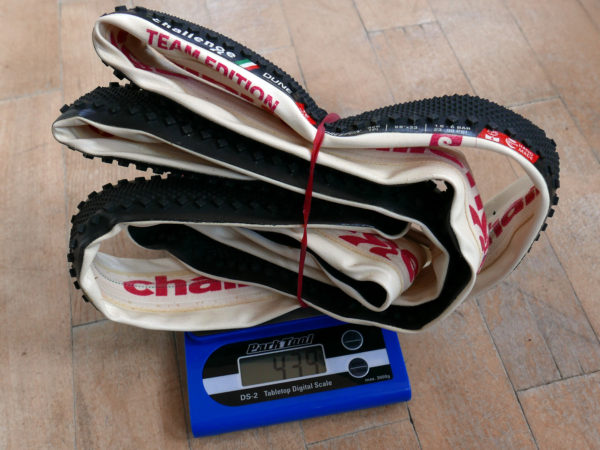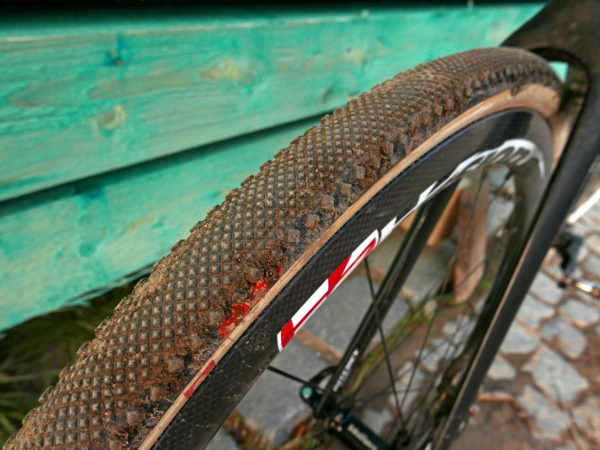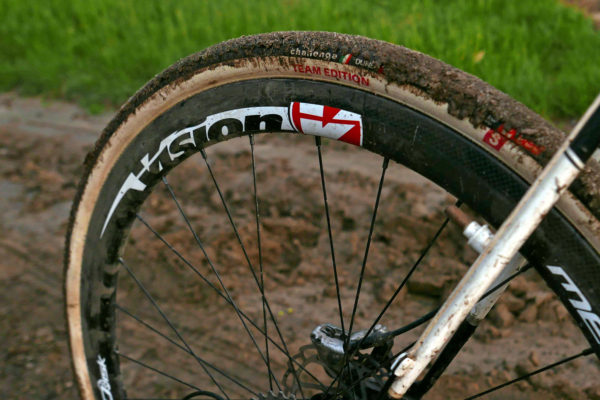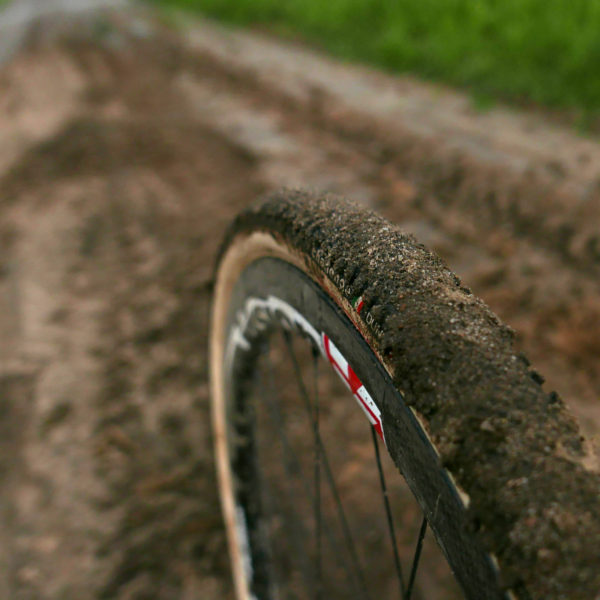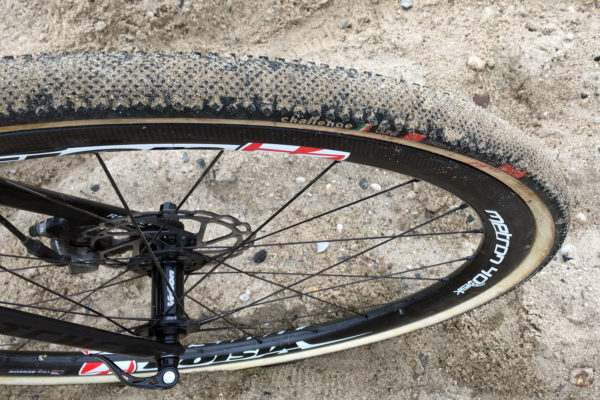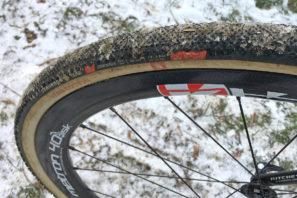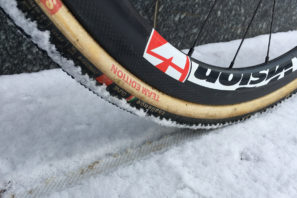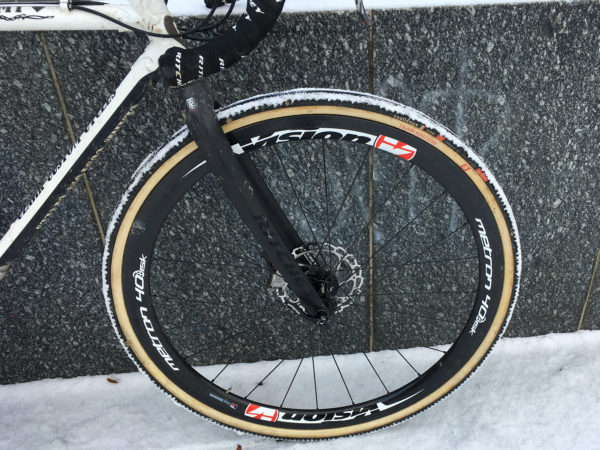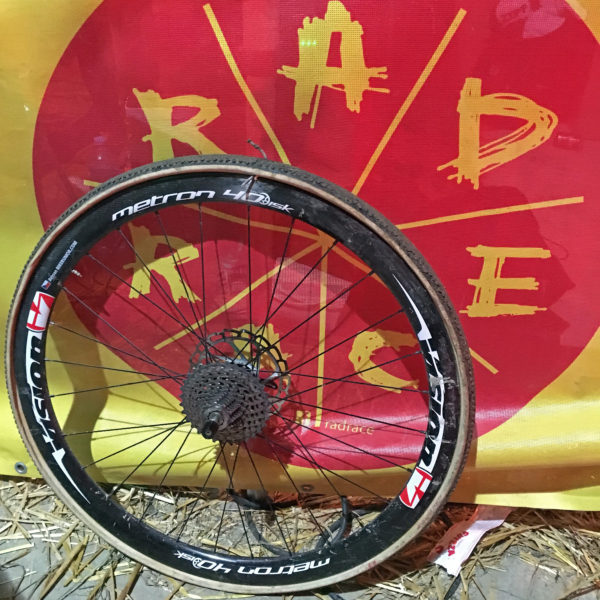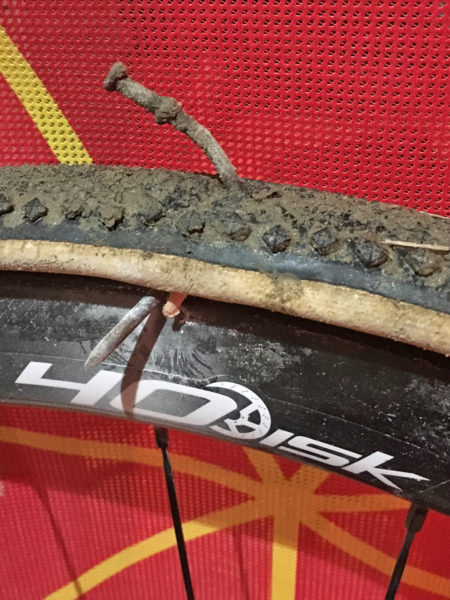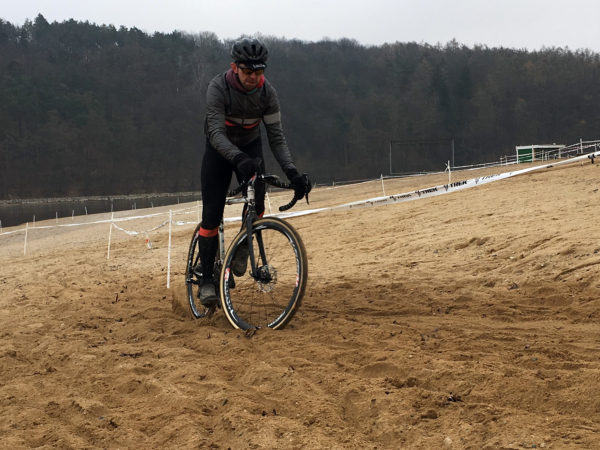If you’ve been keeping up with our USA Cross Nats coverage you may have noticed that new US champ Stephen Hyde rolled across the finish line on a set of Challenge’s latest file tread tubular tires – the Dune. OK to be fair, he walked across the line after a crash in the last off-camber turn hobbled his bike with a broken derailleur hanger and a front flat. Nonetheless, we’ve been testing those same tires since not long after they were introduced at Sea Otter, and as we first learned from past British CX champ Helen Wyman in her tire selection criteria the Dune is capable in much more than the sandy terrain that its name belies…
Tech Details
When we found out that Challenge had a new file tread design I was very curious to try it out. Its last predecessor the Grifo XS had been the first file tread tubular that I was really happy with. And with their most recent hybrid file Chicane Challenge broadened its usability, and then the Baby Limus reiterated a successful formula of making small modifications to update and improve their existing cross tires, rather than starting from scratch.
The Dune keeps the same pyramid file tread down the center as the Grifo XS, but replaces the low dots and half moons of the Grifo with a new set of slightly offset square blocks. With more height and stronger straight edges than it predecessor, the Dune promised more grab when you leaned it into soft turns while retaining the same fast-rolling on the straights. Offsetting the new squares a bit farther down the shoulder also offers more cornering stability & support than the thinner Chicane/Limus shoulder, so the grip continues when you lean it even on hard surfaces where it can’t dig into the surface.
At the same time as the new Dune tread, Challenge had another novelty that we discovered when we looked into the tech in detail back at Eurobike. All of their cyclocross tubulars were now being made available to us regular riders/racers in a Team Edition S corespun cotton casing like the pros use – including the Grifo, Baby Limus, Limus, Chicane, and now Dune. But unlike those boutique made-in-Europe tubulars that often cost twice as much as the Thai-made Challenges, these new T.E. tires got that extra S denoting that their pale cotton sidewalls were pre-sealed with a thin layer of latex giving them similar durability and resistance against rot like their polyester brethren, without having to mess with AquaSeal.
By sealing the casing as it is constructed, the tires are better protected, with no gaps in protection. It also is said to not affect how the tire rides, so you get the full benefit of the pale and flexible 320tpi cotton for a supple feel with crazy grip on command down into super low pressures.
With the new Team Edition S designation also comes a slightly softer rubber compound, which performs better in the wet and especially below freezing temperatures. Softer rubber is sometimes heavier, but the Dunes we tested weighed in on our scale at 439g which is just about 30g heavier than claimed weight, and saves weight over the SuperPoly tires thanks to thinner and more fine casing.
Impressions in Different Conditions
Having ridden the Grifo XS on and off road and raced it in a wide range of conditions, it became a tire that I learned to appreciate on everything from dirty cobblestones and dirt roads to racing on dry grass and packed snow. But with the new Dune’s updated shoulder knobs I was hoping for a bit broader application.
With a name like Dune presumably coming from the classic Dutch & Belgian World Cup Cross races going up, down & across the sand dunes along the North Sea, I thought sand was the best place to try out the new tires. So I took them to the dry sandy and dirty cobblestone roads northeast of Prague and tried to do a fair share of sliding around.
The brand new sharp pyramids did a predictable job of moving the loose sand out of the way to reach down to the hard surfaces below. That worked on hardpack dirt as well as on cobblestones and you can see in the photo above that riding on a hard surface the top of the file treads stayed clean while the loose stuff got pushed aside. Cornering on asphalt, cobbles, or hardpack the Dune felt a bit more confident as you lean over onto the squares, a significant change from the Grifo side which are less constant and reliable feeling.
On rides and races where the sandy sections get mixed in with dirt and hold a bit more moisture, the file section of tread tended to pack up a bit, giving the tire a slower feel and at times more of a sense of slipping & sliding under power. It certainly isn’t a tire to use in the mud.
But at the same time wet sand & dirt didn’t seem to build up much and naturally got squeezed off to the side, never accumulating higher than the square shoulder blocks. That essentially meant that even though you could slip a bit in a straight line, leaning over into the corners and those shoulders dug back in to offer some reliable grip.
I raced a couple of times in proper dry, deep & loose sand as well both in above and below freezing conditions. Running relatively low pressures (~23-25psi for my 80kg weight) the tires floated well and straight through the deepest sections without the shoulder squares producing much drag to eat at my momentum. When I had to power more through the sand though turns and climbing, the center tread and flexible casing did an admirable job at finding grip and the shoulder squares made steering as functional as I could hope.
In the deep turns I still often felt like I was on the edge of my wheel washing out, but it never totally happened. While it doesn’t necessarily feel like being in complete control, I definitely was going faster than those around me through the loosest sections and was able to carry more speed through the deep ruts that many of the others around me had resigned themselves to run. Riding wasn’t always fastest, but it gave me a bit of a confidence boost (and more time on the bike at my max heart rate!)
Most recently winter has taken over and I have put more time on the Dunes in snow and ice. Where they have unexpectedly shined has been with temperatures right around freezing where snow cover has made it hard to guess whether there would be ice or damp grass underneath.
I haven’t been as impressed by the Chicane that often feels to me like it is two opposite extremes, compromised by being together except for very specific conditions. I had used it a bit as it was a better option on wet grass or snow vs. most file treads like the old Grifo XS that just slid all over the place in the wet.
The Dune though seems to offer a better matched straight line and cornering grip that gave me confidence and predictable sliding on either the wet grass under snow or patches of ice. Sure if it gets proper muddy you’ll be out of luck, spinning you wheels and unable to put power to the ground on the straights. But on a course right at the freezing point or a race with few enough riders to not churn up the mud too bad, the loose spots will be in the corners and that’s where the Dune shoulder squares will offer confidence inspiring traction.
I already had expected good performance in the deep freeze kind of snow riding that is either packed tracks or the white stuff hiding lot of full on ice beneath it. It seemed counter intuitive at first ride many years ago, but file treads in the snow are like velcro, just tons of tread surface area grabbing the powder. And really like in soft sand, you don’t want big side knobs which will just chew up the track surface and throw it at your bike and drivetrain.
Then when you hit the ice, it’s again a case of the more rubber against the ground, the better chance of staying upright. Again you want smooth transition to the side knobs. You want to avoid cornering on ice, but inevitably you’ll run into frozen ruts, where it is still best to keep low profile side knobs and as much sticky rubber on the ground.
In the cold I think I most appreciated the softer rubber of the Team Edition tires. I don’t feel like there is that much difference in tire compound that I would be able to quantify, but the tires grip and make me feel comfortable with that traction.
Final Thoughts
OK, that’s a lot of words about a couple of file tread tubulars. To sum it up, the Dunes are a predictable file tread tire with a smooth feeling transition to stable shoulder knobs that offer support and positive grip in the corners. Those simple characteristics make the Dune a surprisingly versatile tread. While they don’t suit muddy conditions, they outperform most other fast-rolling cross tires I’ve ridden once the ground starts to get damp or even wet.
Combined with the T.E. S casing they make a supple tire that offers ample grip and pretty solid security. They even have Challenge’s single layer puncture protection strip (PPS) under the tread to protect the latex tube inside from flats. Sure that was no match for the 10cm/4″ nail that I picked up in the junkyard section of the Rad Race cross race at this year’s Vienna Bike Show. (No, it didn’t buff out.) But as a testament to the versatility of the tire, instead of trying something else, I bought myself a replacement so I could keep racing on them.
One of the things I learned riding my previous sets of file treads was that it could be a blast getting fast and loose with a tire outside of its comfort zone. I still feel like that holds true with the Dune. Getting used to a tire that you can slide through turns is a lot of fun and good cyclocross training. But the Dune has a much wider application than its name implies.
Sure it does great in the sand, and for any race I’ll be doing anytime soon with significant amounts of sand, this is the first tire I’d reach for. But if you read our feature on Helen Wyman’s method for picking cyclocross tires, you’d have seen the name Dune pop up as a viable first or second option for 6 out of 11 of the different course terrain categories. So when Stephen Hyde switched to the Dunes mid-race before taking the men’s Elite National Championship win on the snow covered and frozen course in Hartford, I was certainly not surprised.
